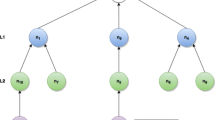Abstract
Network lifetime maximization is challenging particularly for large-scale wireless sensor networks. The sensor nodes near the sink node tend to suffer high energy consumption due to heavy traffic relay operations, becoming vulnerable to energy depletion. The rationale of the sink mobility approach is that as the sink node moves around, such risk of energy depletion at some nodes can be alleviated. In this paper, we first obtain the optimal mobile sink sojourning pattern by solving a linear programming model and then we mathematically analyze why the optimal solution exhibits such sojourning pattern. We use the insights from this analysis to design a simple practical heuristic algorithm for sink mobility, which utilizes only local information. Our heuristic is very different from the existing algorithms which often use the traffic volume as the main decision factor, in that we consider the variance of residual energy of neighboring sensor nodes. The simulation results show that our scheme achieves near-optimal network lifetime even with the relatively low moving speed of the mobile sink.
























Similar content being viewed by others
Notes
The mobile sink sojourns 100 % of time in the boundary area of the network under PERIMETER scheme. While a similar migration path is resulted by OPTIMAL, in PERIMETER scheme, the mobile sink has the same sojourn times at all locations on the boundary of the network, which is the key difference from OPTIMAL.
References
Zhao, F., & Guibas, L. (2004). Wireless sensor networks: An information processing approach. San Francisco: Morgan Kaufmann Publishers.
Cordeiro, C., & Agrawal, D. (2006). Ad hoc ans sensor networks: Theory and applications. Singapore: World Scientific.
Yick, J., Mukherjee, B., & Ghosal, D. (2008). Wireless sensor network survey. Computer Networks, 52, 2292–2330.
Gandham, S. R., Dawande, M., Prakash, R., & Venkatesan, S. (2003). Energy efficient schemes for wireless sensor networks with multiple mobile base stations. In Proceedings of IEEE Globecom’03.
Wang, Z. M., Basagni, S., Melachrinoudis, E., & Petrioli, C. (2005). Exploiting sink mobility for maximizing sensor networks lifetime. In Proceedings of HICSS’05.
Basagni, S., Carosi, A., Melachrinoudis, E., Petrioli, C., & Wang, Z. M. (2008). Controlled sink mobility for prolonging wireless sensor networks lifetime. Wireless Networks, 14, 831–858.
Donepudi, V., & Younis, M. (2009). Employing sink mobility to extend the lifetime of wireless sensor networks. CollaborateCom/LNICT, 10, 355–369.
Luo, J., & Hubaux, J.-P. (2005). Joint mobility and routing for lifetime elongation in wireless sensor networks. In Proceedings of IEEE Infocom’05.
Yun, Y., & Xia, Y. (2010). Maximizing the lifetime of wireless sensor networks with mobile sink in delay-tolerant applications. IEEE Transactions on Mobile Computing, 9, 1308–1318.
Keskin, M. E., Altinel, I. K., Aras, N., & Ersoy, C. (2011). Lifetime maximization in wireless sensor networks using a mobile sink with nonzero traveling time. The Computer Journal, 54, 1987–1999.
Shi, G., Liao, M., Ma, M., & Shu, Y. (2008). Exploiting sink movement for energy-efficient load-balancing in wireless sensor networks. In Proceedings of ACM FOWANC’08.
Gao, S., Zhang, H., & Das, S. K. (2011). Efficient data collection in wireless sensor networks with path constrained mobile sinks. IEEE Transactions on Mobile Computing, 10, 592–608.
Xing, G., Li, M., Wang, T., Jia, W., & Huang, J. (2012). Efficient rendezvous algorithms for mobility-enabled wireless sensor networks. IEEE Transactions on Mobile Computing, 11, 47–60.
Wang, G., Cao, G., & La Porta, T. (2004). Movement-assisted sensor deployment. In Proceedings of IEEE Infocom’04.
Wang, G., Cao, G., La Porta, T., & Zhang, W. (2005). Sensor relocation in mobile sensor networks. In Proceedings of IEEE Infocom’05.
Liu, C.-H., & Ssu, K.-F. (2008). A moving algorithm for non-uniform deployment in mobile sensor networks. In Proceedings of ACM Mobility’08.
Wang, W., Srinivasan, V., & Chua, K.-C. (2005). Using mobile relays to prolong the lifetime of wireless sensor networks. In Proceedings of ACM Mobicom’05.
El-Moukaddem, F., Tong, E., Xing, G., & Kulkami, S. (2009). Mobile relay configuration in data-intensive wireless sensor networks. In Proceedings of IEEE MASS’09.
Yang, Y., Fonoage, M. I., & Cardei, M. (2010). Improving network lifetime with mobile wireless sensor networks. Computer Communications, 33, 409–419.
Fonseca, R., Gnawali, O., Jamieson, K., Kim, S., Levis, P., & Woo, A. (2006). TEP 123: The collection tree protocol.
Kim, Y., Lee, K., Sim, S., & Han, S. (2011). A simple myopic mobile sink strategy for wireless sensor networks. In Proceedings of IEEE IPCCC’11.
Acknowledgments
This research was funded by the MSIP (Ministry of Science, ICT & Future Planning), Korea in the ICT R&D Program 2013.
Author information
Authors and Affiliations
Corresponding author
Additional information
The earlier version of this paper is published in [21].
Rights and permissions
About this article
Cite this article
Lee, K., Kim, YH., Kim, HJ. et al. A myopic mobile sink migration strategy for maximizing lifetime of wireless sensor networks. Wireless Netw 20, 303–318 (2014). https://doi.org/10.1007/s11276-013-0606-9
Published:
Issue Date:
DOI: https://doi.org/10.1007/s11276-013-0606-9




